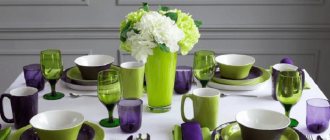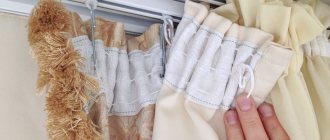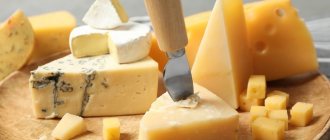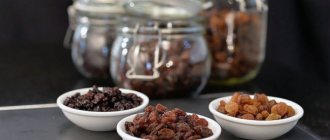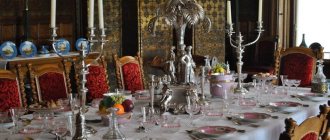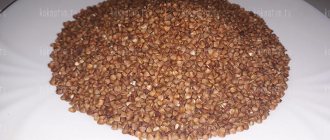The good taste of the dishes should be combined with a beautiful table setting that creates a good mood. Of course, everyone can set the table to their own taste. The main purpose of table setting is the neatness, convenience and attractive appearance of the table. There are several types of table settings for lunch and dinner.
History and emergence of the art of serving
The first mention of table setting dates back to the early Middle Ages. Then people did not pay attention to the decoration of the table, and the cutlery had only a functional component. In the 13th century. Wax candles on the table were used only for lighting, but today they are an important element of decor.
Medieval people did not know about plates - their role was played by special recesses in the wooden surface of the table. The nobility decorated such recesses with carved ornaments, emphasizing their status and wealth. However, this tradition did not last long: the food quickly got stuck in the pattern, the ornament darkened and began to emit an unpleasant odor.
In the Middle Ages, the first table knives appeared, intended only for eating. Before this, pieces of food were put into the mouth with hands or with the help of combat daggers. Since abundant feasts were often accompanied by heated quarrels and showdowns, guests were offered special devices with a rounded blade. This helped reduce the number of tragic deaths at the holiday table.
In the 10th century The role of the plate changed: thick slices of bread began to be placed on it. Meat, sauce and other fatty dishes were laid out on them, and after the feast, bread soaked in the remains of the food was given to the poor near the fortress wall. Food was served on dishes, each of which was designed for 2-3 people.
In the XI-XII centuries. tables began to be covered with tablecloths made of heavy fleecy fabric with elegant embroidery. At the same time, the first five-prong forks appeared. They were expensive, so it was customary to bring your own device when visiting. The personal fork gradually turned into a status element, indicating the wealth of the owner. The size of the cutlery also mattered. History has recorded cases where aristocrats at feasts remained hungry because their forks did not fit in their mouths. This is where special two-pronged forks for poultry and meat came from.
The modern type of plates appeared by chance. One of the British knights ordered a foundry to produce a set of small dishes. Whether he wanted to save money or sought to place more guests on the table, no one knows. But the idea turned out to be successful, and gradually plates appeared in every European home.
XVIII century called the golden age of serving. Saxon craftsmen had been making porcelain for a long time, and then learned to cover it with glaze. The production of cutlery was also actively developing. Each workshop tried to make its products special through different shapes, abundance of decor, and a wide selection of materials. This is how Europe was hit by a crockery boom.
As a result, serving and serving food has become a fine art. Tables began to be decorated with candles, flowers, figurines, and a variety of cutlery was assigned for each guest. Skillfully folded napkins became a sign of the exquisite taste of the inviter.
XX century marked by the emergence of fast food. Plastic and cardboard utensils have appeared in catering establishments. However, fine dining restaurants still compete in the art of elegant table setting.
How to lay a tablecloth
Textiles on the table set the tone for the entire setting. A tablecloth as a background can emphasize the solemnity of the moment, or, conversely, ruin the mood. Therefore, it must be spotlessly clean, intact and without scuffs. It is checked in advance, washed and ironed.
According to the general rules of table setting, the tablecloth is chosen in accordance with the occasion of the celebration:
- A formal reception calls for white damask fabric. This is the name given to a linen or cotton tablecloth woven with shiny convex patterns. You can replace it with smooth linen or linen, but damask looks more solemn. A soft lining is spread under the main tablecloth so that cutlery and plates do not knock when serving and during the meal. For this purpose, use felt or felt, cut to the size of the tabletop. To set the table at home, you can use a sheet folded several times.
- A gala dinner in an old mansion or a room designed in the style of a “noble nest” can be decorated with a lace or embroidered tablecloth. However, you should not choose bright and lush patterns.
- Light, elegant and sometimes bright embroideries are more suitable for calm family celebrations and setting a festive table at home. In this case, you need to make sure that the pattern is positioned strictly symmetrically relative to the contours of the table.
- Modern etiquette allows the use of colored tablecloths matched to the porcelain and napkins. However, it is not advisable to get too carried away with bright colors. Soft pastel shades chosen taking into account the style of the room, decor and occasion of the celebration will look good. For example, bluish and greenish tones will add coolness to a sunny dining room, and shades of yellow will warm you up in the winter cold.
- Colorful, brightly colored tablecloths will be more than appropriate at a children's party or themed party. Setting the table with rich tones is acceptable for breakfast or tea.
Formal reception
Gala dinner
For family celebrations
For children's parties
The tablecloth should be ironed before use, even if it has been stored very carefully. Traditionally, vertical and horizontal folds running strictly in the center are smoothed out. When placed on a table, they should divide the tabletop into four equal parts, aligning the center of the furniture with the center of the canvas.
How to properly set a table with a tablecloth:
- shake it over a piece of furniture to create an air gap;
- align the centers of the table and tablecloth;
- place it so that the corners of the canvas cover the legs, and the edge goes down 30-50 cm (less is not aesthetically pleasing, more is inconvenient).
At the end ends of the dining table, the tablecloth can hang a little lower unless there are guests sitting there. For a buffet table, a fairly long tablecloth is usually used, since there are no seats at the table. However, under no circumstances should it touch the floor.
The need for table setting
Eating is an important part of every day. Eating while running or while watching TV not only spoils your mood, but also leads to negative health consequences. Indigestion, gastritis and excess weight can occur in just a few months of careless attitude to the process of food absorption.
Table setting allows you to turn dinner into a special event filled with aesthetic pleasure. Even simple everyday dishes, when properly prepared, will whet your appetite. Cutlery placed on both sides of the plate will make movements smooth and precise. The meal time will increase, and the stomach will have the opportunity to gradually digest incoming foods.
Some tips
- Think over, prepare and purchase all the necessary serving elements. Tidy up the tablecloth.
- Decide on the dishes, wash them. Multi-colored dishes will not do any harm, but if they are in an unsightly condition, it will spoil the impression of the whole event. Arrange the number of items according to the composition of the guests, have several additional plates in case of miscalculations.
- Glasses and wine glasses are used according to the drinks. Learn the types and rules for serving alcoholic and non-alcoholic drinks.
- Serve based on the theme of the event. Knives are removed at children's parties. Additional decorative elements, such as candles and vases of flowers, help create the atmosphere.
- Don't be afraid to show your individuality. Look on the Internet how interesting it is to arrange fabric napkins, and place a small handmade gift for each guest.
- Don't forget the spices. Guests have varied tastes, and the presence of additional spices will allow you to please your guests.
Table setting allows you to express interests and personality. A way to show guests thriftiness and homeliness. Don’t forget about yourself, because it is doubly pleasant to dine in a beautiful atmosphere, to receive not only the benefits of food, but also pleasure from the process.
General rules
Setting the table is a ritual, the rules of which are universal for most countries of the world.
Having learned them, you can safely visit restaurants in Russia, France, Turkey, and Japan.
Types of plates
It is impossible to imagine a festive table without serving plates. They can be of various shapes and depths.
Each type of plate has its own purpose:
- The dining room is deep. This dish is intended for serving first courses: soups, okroshka, broth. Can be of different sizes: for half or full portion. Served on the table in a serving plate. After eating the dish, it is replaced with a small plate.
- The dining room is small. Designed for serving second courses: side dishes and meat filling. The diameter of the plates varies from 24 to 30 cm. If necessary, small plates can be replaced with serving plates.
- The diner is big. It has a flat shape and is intended for serving cold appetizers, cold cuts and cheese. The plates are placed on the table at an equal distance from each other so that everyone can reach them. If desired, they can be used as a stand for personal frying pans or salad bowls.
- The snack bar is small. It has the same shape as the previous one, but with a smaller diameter. Sometimes such plates become personal and are placed at the beginning of the feast in front of each guest.
- Pirozhkovaya. A small, plain plate with a smooth edge. Used for serving bread, sweet and savory pastries, cheese, uncut fruits.
- Dessert deep. Differs from the dining room design with fruit, cakes or flowers on the bottom or edges. Designed for desserts.
- Dessert small. Used to serve individual dessert to each guest. It has wavy edges and a pattern on the surface.
- For fish. It has an elongated oval shape, allowing you to place a whole fish on a plate. This makes the dish look attractive to guests.
- Chill plate. Still exotic tableware in Russia. It is made in the form of a small shell and serves for serving vegetable caviar, stew, salad or oysters.
- Menazhnitsa. A plate divided into sections, each containing a different ingredient of the dish: olive oil, sauce and shrimp or jam, honey, preserves, various types of chopped fruit, etc.
- Salad bowl. It is used for both festive and everyday serving. It is customary to serve large salad bowls with tongs or serving spoons.
- Herring fisherman. Dishes for serving salted herring and other fish delicacies.
- Caviar. A small, flat-shaped dish intended for fish caviar. More often served at ceremonial feasts.
Types of devices
When sitting at a festive table, it is important to be able to use all types of cutlery, including:
- Standard. It is used both for eating and for serving dishes, unless special tools are provided for this.
- Snack bar. Smaller size compared to standard. Suitable for pancakes, meat snacks, etc.
- Fish. Indispensable when serving fish dishes. The fork has a recess for separating bones and 4 small teeth, the knife has a wide short blade.
- Dessert. A set of small forks, knives and spoons with an elegant design.
Table decor
When decorating the table, you need to remember that everything should be in moderation. An abundance of decorative elements may confuse guests or leave no room for dishes with treats. For them, it is better to highlight the center line of the table. This is especially convenient when dishes are served individually.
You can also prepare a small surprise for each guest: when preparing a New Year's celebration, tie the cutlery with a satin ribbon, put sparklers in glasses or place crackers near the napkins. A good solution would be designer Christmas tree decorations laid out on the table. After the holiday, each guest will be able to take such a souvenir with them.
When thinking about decorations, it is better to stick to one style or theme, avoiding pretentiousness. If the table is decorated in the loft or minimalist direction, it is better to limit textile elements to napkins. In all other cases, a tablecloth is required. It can be either large, richly decorated with embroidery, or a narrow path or individual plates for cutlery.
Floral decor is appropriate for any season and for every celebration. In summer and spring it can be a bouquet of wild or garden flowers, in winter it can be a small coniferous composition.
Selection of glasses and glasses
The abundance of drinkware on the table can confuse even an etiquette teacher:
- "Flute". A classic, elongated glass designed for champagne, sparkling wine or cocktails based on them.
- Bowl-wine glass. It has a wide neck, thanks to which the gas from the drink evaporates faster.
- For red wine. The glass has a round shape and a wide bottom. Allows the wine to be more actively saturated with oxygen, revealing the finest nuances of taste and aroma. The high stem prevents unwanted heating of the drink from the heat of your hands. For red Burgundy wine, which has a sour taste, large glasses (700 ml volume) are intended. By rotating them opposite the light source, you can enjoy the play of highlights and shades of this noble wine.
- For white wine. Small glasses with a bowl tapering towards the top. More elongated compared to the previous ones, also having a thin, high leg.
- For liqueurs. The glass is used only for the specified drink in undiluted form. Served after the meal.
- For sherry. The figurative shape of the glass has been preserved since the beginning of the twentieth century. The triangular shape of the bowl allows the alcohol to evaporate quickly.
- Snifter. We recognize it by its short, thick stem and wide, tapering bowl with a massive bottom. Traditionally used to serve brandy, Calvados, cognac and Armagnac. It fits comfortably in the palm of your hand, thanks to which the drink heats up, revealing all the notes of its bouquet.
- For whiskey. A small but capacious glass designed for drinks with a lot of ice. Thick walls prevent the ice cubes from melting quickly.
- “Shot” with a thick bottom. Having a volume of no more than 40-60 ml, it is intended for strong, very chilled alcoholic drinks that are drunk in one sip.
- A tall glass with a wide neck. Used for both beer and cocktails.
- Beer mug up to 1 l.
- "Highball." The glass has strong walls and a thick bottom. Suitable for water, cocktails and soft drinks.
- Cocktail glass. Recognizable by its triangular shape with a wide top. Most often it serves martinis.
Using napkins
Textiles are a must-have attribute both at holidays and at home. It performs not only a hygienic, but also an aesthetic function, emphasizing the interior and theme of the event, giving the table an elegant and finished look.
The table design requirements require the use of one color scheme in all details. Dishes, cutlery, desserts, textiles should resonate with each other.
When making a choice in favor of one material or another, you need to correlate it with the form in which the accessory will be offered to the guest. Some compositions require greater rigidity, while others are suitable for soft fabrics. Regardless of the installation method, the figurine should quickly unfold and fulfill its intended purpose. An effective addition will be holders, rings and shapes selected in the same style.
Types of napkins and their location
Napkins are not only an important element of guest hygiene, but also an effective decorative element. Accessories based on the material used are divided into paper and fabric. Cloth napkins are large in size and designed to be placed on your lap to prevent food from accidentally getting on your clothes. Paper ones are used when eating to clean hands, remove bones, etc.
Fabric ones are distributed individually to each guest, paper ones are placed on the table in large quantities so that they are available to everyone. During a large feast, several napkin holders are placed, evenly distributing them around the table.
Paper and fabric napkins are placed in a folded position or assembled into various shapes. Quirky and interesting accessories give the table a special charm. Have a small supply of napkins.
Classic version
The classic serving option involves a white tablecloth, metal cutlery and crystal glasses without any color accents. You need to start by laying out the tablecloth, leaving an overhang of 20 to 30 cm. It can be supplemented with underplates or narrow runners. Next, a serving plate is placed for each guest, and a soup plate is placed on it. On the left is a snack bar, dessert or salad bar. The distance between the plates is 1.5-2 cm. If the appetizer or dessert plate slides along the serving plate, you can put a textile or paper napkin between them.
Now you can lay out the devices. The sequence is as follows: to the right of the plates are knives and spoons, to the left are forks. The order of arrangement corresponds to the order in which the dishes are served. Glasses are placed behind the plates on the right side: from largest to smallest.
Varieties and subtleties
Serving varies. Its features are determined by the time of day and the characteristics of the festive event. For breakfast, a minimum number of dishes is served, so the number of utensils may be limited. Dinner requires a lot of dishes.
For breakfast
This is the simplest option. To properly set the table, you should place small plates. Next, place glasses and cups, saucers with teaspoons. When using utensils for butter, it is worth adding an extra spoon. Place a bowl on top of the appetizer plate. You can eat porridge from it.
On weekends, breakfast includes tea. That’s why they place a teapot or coffee pot in the center of the table. Original napkins are used for table decoration. It is also acceptable to use flowers.
For dinner
Lunch serving comes in different options. It is influenced by the number of dishes and their composition. It is recommended to lay a white tablecloth on the table and place plates on top.
If dishes are served that cannot be eaten from a common container, an additional small plate is placed. Devices should be placed based on etiquette recommendations. For decoration, napkins folded in an original way are used. A salt shaker and other equipment for spices must be placed on the table.
Full evening
Family members and friends can be invited to dinner. To ensure convenience and comfort, it is worth considering the design of the table down to the smallest detail.
To ensure a perfect celebration, you should adhere to a number of rules:
- Lay out a clean and well-ironed tablecloth. It is recommended to choose a dense product. This will help avoid ringing when the dishes fall.
- Choose items that match colors. All components must be included in one set. The dishes must be crystal clean.
- Unopened bottles of alcohol should not be placed on the table. It is recommended to serve alcohol in open containers and immediately pour it into glasses. Textile napkins are placed near the glasses.
Banquet room
This table setting resembles a full evening one. At the same time, there are certain peculiarities. It is recommended to place shallow plates at a distance of 1 centimeter. This begins to be done from the central part. First, the plates are placed on one side, then on the other. These items should be located opposite each other.
It is recommended to place saucers for appetizers and pies on the plates. Next is to arrange the devices.
A characteristic feature of a banquet feast is the use of special personalized cards. They contain information about the participant in the celebration. Such cards are placed on the left side of the glasses.
Buffet room
This type of serving is becoming increasingly popular. It is often used for closed parties or informal meetings with business partners. Buffets are often organized at official celebrations.
Serving can be one- or two-sided. They are characterized by certain features. In the first situation, the table is placed near the wall and decorated on only one side. The second option is used for anniversaries, wedding parties, and corporate events.
When organizing a buffet table, you should maintain equal spaces between the cutlery and other elements. First, glass and crystal dishes are placed on the table. Then vases with flowers and alcohol are placed in the center. Often a separate table is used for drinks and snacks.
Coffee shop
Coffee service depends on the drinks. Strong coffee prepared on the stove is poured into porcelain cups. You should definitely use one service. To create the perfect drink, you can use a geyser coffee maker.
When serving coffee, cups should only be filled 2/3 full. This will give guests the opportunity to pour cream or milk. With this type of serving, 3 items are used - a cup, spoon and saucer. Additional details include a dessert plate. It is intended for sweets or fruits.
Teahouse
The main dish is placed in the center. A pie is placed on it. A cup, saucer and required cutlery are placed near each guest. Dessert plates are often used. The teapots are placed at the edge of the table. When using a samovar, it is placed in the central part.
Table setting scheme
The general rules for setting the table apply in all situations, but there are some nuances.
For breakfast
For breakfast, place a deep bowl for porridge on a serving plate. The fork is placed on the left side, the knife and spoon are placed on the right. A little further to the left is a bread plate with a butter knife. On the right there is a coffee or tea pair, a glass for juice or water.
For lunch
The dinner table is set as follows: a soup or snack bar is placed on the serving plate, a pie plate is placed on the left, a wine glass and a glass for water are placed in front. A knife and spoon are placed on the right side of the serving plate, and a fork is placed on the left.
For dinner
The technology of preparing for dinner involves laying out a large number of dishes, depending on the types of dishes served. Since drinking strong alcoholic drinks is appropriate in the evening, several types of glasses can be placed next to the serving plate. A tea table can be placed next to the main one.
Serving procedure at home
When serving, it is recommended to take into account many features. First of all, the order in which the elements are placed on the table is of particular importance.
Tablecloth
The serving process begins with choosing a tablecloth. If you are planning a special event, you should give preference to shiny materials. Rough linen is good for a laconic table.
The material must be clean and ironed. In this case, it is strictly forbidden to cover it with oilcloth. The canvas should be placed so that it drops at least 25 centimeters. The material should not hang below the seat. A tablecloth that is too long will cause discomfort.
Dishes
A decorative plate is placed in the center. It is necessary to maintain a distance of at least 2 centimeters from the edge. Place dishes for soups or snacks on top. For pureed soup, a soup bowl works well. If you plan to serve clear broth, use a cup.
Cutlery
The cutlery is placed along the edges of the plate. They are also placed on top. It is recommended to place forks on the left. They are directed with their horns upward. Knives are placed on the right, pointing the blade towards the plate.
The device that will have to be used first is placed on the edge. That’s why snack items are placed furthest away.
If there is no dessert, a tablespoon should be placed on top of the plate. If a sweet dish is provided, the device is placed to the right of the knives. Dessert items are placed above the plate.
Glasses, wine glasses, glasses
It is recommended to provide separate containers for drinks. Cognac or red wine is poured into large glasses. Small glasses are suitable for white wine. Champagne is drunk from tall and narrow glasses. At the same time, cocktail glasses are often used for juice. They often also contain water.
It is recommended to place a glass of water 50 centimeters from the end of the knife. Then a wine glass is placed at an angle of 45 degrees from the edge of the table. A vodka glass can be placed in the same place.
Napkins
Guests are provided with individual napkins. It is recommended to fold them beautifully at the end of serving and place them on a plate for appetizers. There are many methods for folding this element.
Decor and design
To provide guests with a good mood and put them in a festive mood, it is worth using stylish decorative elements
It is important to maintain a sense of proportion. Such additions should not interfere with the arrangement of dishes
A figurine can be a stylish addition to the table. Candlesticks will look very attractive. They should be combined with sophisticated dishes and glasses.
Flowers are considered a good addition to the holiday table.
At the same time, it is important that they look harmonious and do not create inconvenience. Therefore, the bouquet should not be larger than the tallest glass
If you are planning a themed celebration, it is recommended to choose appropriate accessories. For the New Year's table, decor in the form of fir branches, balls, and tinsel is suitable.
Children's table
Before setting the children's table, you should choose the theme of the celebration. There is no special scheme; you can cover it in any order convenient for small guests. Sliced fruits are offered as a healthy dessert for children, so you can’t do without a special shelf on the table.
Instead of drinking glasses, you can use baby food jars, pre-decorated to match the overall style. They are strong enough not to break if dropped from children's hands, have no sharp edges and look original.
If you wish, you can save money and decorate the table using a disposable tablecloth and paper tableware. In this case, you need to give preference to safe materials and bright, rich colors.
How to decorate a table for a holiday
Setting a festive table for any event, some tips for organizing a festive table. It’s not enough to prepare delicious dishes for the holiday to be a success, you also need to decorate the entire room, table and don’t forget to dress up yourself, while being able to convey the mood of the holiday. Therefore, it is better to study everything in advance, plan and present an impeccable table to your guests. Is it possible to surprise guests without unexpected decor, intricate name cards, and arrangements with candles? But keep it in moderation, as too much trinkets will look tacky and chaotic.
Let's start decorating the table by selecting a tablecloth and napkins. When choosing accessories and decorations for them, decide in what color scheme everything should be done. Do not lose sight of the fact that the tablecloth and dishes should be combined harmoniously. If you don’t yet have a suitable tablecloth that would match your favorite set, then perhaps you can arrange a piece of ordinary fabric on the table as a tablecloth. This tablecloth format can be matched to any tableware; you will have the opportunity to change it every time and not repeat it. If the tablecloth is monotonous in color, add a catchy set of flowers to it. You can complement this set with matching ribbons. A tablecloth and napkins made in the same style look grandiose. An old tablecloth can be jazzed up with tulle placed in the center or ribbons crossed into a weave of parallel lines across the table. Use Lurex only if your holiday will take place in the evening, when the lights in the house are on. This will make the shiny fabric shine advantageously and fill the atmosphere of the table with sophistication.
Other serving details
Table setting has many nuances when it comes to national cuisine. For Japanese dishes, it is mandatory to have bamboo chopsticks and a separate place for each guest. In Kazakhstan, the tradition of dastarkhan is alive, according to which the table is richly decorated with embroidered tablecloths, and dishes are placed close to each other. The table in Scandinavia is distinguished by a restrained and eco-friendly style: natural materials, neutral colors, compositions of pine needles, moss and edelweiss. They will make the meal calm and cozy.
Features and rules for decorating a festive table
To properly set the table, it is worth considering many features - first of all, the style and format of the event.
See also
How to Design Small Bedrooms, Modern Layouts and Ideas
Festive dinner
On holiday, the table can be decorated with beautiful candles and dishes. Light snacks are served first. Then you can put the main course, fruit and dessert on the table.
Romantic dinner
This dinner requires a minimum of cutlery and glasses. Place fresh flowers and candles in the center of the table.
Red napkins and runners will help complement the design.
Thematic
Products grown at the dacha will help you prepare a themed table. Vegetable compositions are used as decoration.
With a friend
For a meeting with a friend, a delicate tablecloth and a minimum of cutlery are suitable. The best option would be light dishes - for example, seafood.
For friends
In this case, serving should be as simple as possible. At the same time, it is important to prepare several delicious dishes.
For children
You should not put a lot of cutlery on the table. In this case, a standard set of fork, spoon and knife will do. It is important that the devices are safe.
For the New Year
The New Year's table is always decorated with candles. They should be placed in the center. You can also make a composition from fir branches, add balls and figures.
Dessert table
It is important to think it through to the smallest detail. All items must be made in the same style. It is advisable that the color of the napkins and tablecloth match.
Boho style
In this case, it is permissible to use many elements and color schemes. The plates can be decorated with geometric patterns. You can put glasses made of multi-colored glass.
Easter table
A natural tablecloth made in a pastel palette is suitable for such a table. Bright napkins can be used as decoration. You should definitely use egg cups. In the center there can be compositions of eggs, willow, and rabbits.
For a birthday
When decorating a table for an anniversary or other birthday, it is worth using many elements - beautiful dishes, shelves for fruit, straws for cocktails.
Glasses, shot glasses, wine glasses
Glasses, wine glasses and shot glasses are placed last.
- The first to be placed is a glass, which is intended for water or juice and is located approximately one centimeter from the tip of the knife.
- Then the remaining glasses are lined up. In this case, there are three ways of arrangement: in length, in a semicircle and in a block.
In any of them, you must adhere to the rule: low glasses are placed in front of tall ones.
But you should not put more than three glasses. However, when fully served, drink containers are lined up in two rows. The distance between objects should be at least 0.5-1 centimeter.
Today there is a tendency to minimize the number of glasses: one universal glass or two glasses: one for red wine and one for white - or one universal glass and another for white wine.
As for the choice of glasses, the order here is the same as with cutlery: the farthest glass is used first.
For centuries, people have been drinking various drinks from glass or crystal glasses. Today, glasses made of clear and colored glass are considered fashionable.
Smooth glasses with thin stems are most welcome - any wine looks great in them.
And if the bowl of the glass itself is very simple, then its stem is often distinguished by the most unusual shape - this is where the whole “zest” lies.
If it is intended to serve only water, then a wine glass or glass is placed behind each plate, in the center or slightly to the right.
It should be located at the intersection of the top edge of the plate with the end of the first knife.
And if fruit drink or kvass is served instead of water, then a mug is placed instead of a wine glass, with the handle facing to the right.
We must remember that if wine is served at the table, then the appropriate glass for white or red wine should be placed on the right behind the knife.
If several drinks are served (beer, juices, water), the remaining glasses should be placed in the same order in which the drinks are served.
Each type of wine corresponds to glasses of a certain shape: in them, drinks retain their taste and aroma.
Shot glasses and glasses are used for spirits and liqueurs, white and red wine, champagne and, of course, for mixed drinks and cocktails.
It should be remembered that glasses for alcoholic drinks must be made of transparent, colorless glass. Only white wine can be poured into colored glasses.
Already in the century before last, tall, narrow glasses began to be used for champagne. The drink “plays” in them, foams and does not dry out so quickly.
This shape of the bowl promotes the formation of bubbles that rise from the bottom to the top.
Those who serve champagne in low and wide glasses are making a mistake. Such a container is not suitable for champagne - the wonderful sparkling drink does not foam in it.
Whiskey should be poured into straight, tall glasses. The container should be filled no more than one third. Whiskey is usually drunk with ice or soda water. But you can drink without it, as you like.
Cognac is drunk from special round glasses, narrowed at the top, with closed legs - such that the drink poured at the bottom is warmed by the warmth of the palms. The shape of the bowl resembles an apple or a tulip.
Red wine glasses are larger than cognac glasses and also look like a tulip, but slightly open at the top.
In such a container, the wine is quickly enriched with oxygen, and after “inhaling” it will delight you with its aroma.
For white wine, a glass with a high stem is suitable; it is slightly smaller in size than a champagne glass.
A large wine glass with a wide bell-shaped bowl is intended for light white wines. If such a glass is frequently shaken, the wine will remain cool and refreshing for a long time.
Sweet and dessert wines are poured into small tulip-shaped glasses. Even smaller are the glasses intended for liqueur.
A large, wide, spherical glass, larger in size than a wine glass, is often used.
Cheap red and white wine is usually poured into such containers. This glass is suitable for both beer and martinis with ice or tonic.
And the smallest shot glasses are intended for vodka.
Popular message topics
- Hoodo Temple Japan
In Japan, there are many temples that adhere to one or another religious direction. One of the guardians of the religious traditions of Buddhism is the Hoodo Temple. Today it represents the preserved part of ancient buildings, - Social Insurance Fund
The Social Insurance Fund is an extra-budgetary and state structure. This fund was created to provide compulsory social insurance for the country's citizens. - Air Air
is an integral part of our planet and habitat. Without him it was impossible to even imagine life on earth. After all, air is the most important component that ensures the existence of all living organisms,
